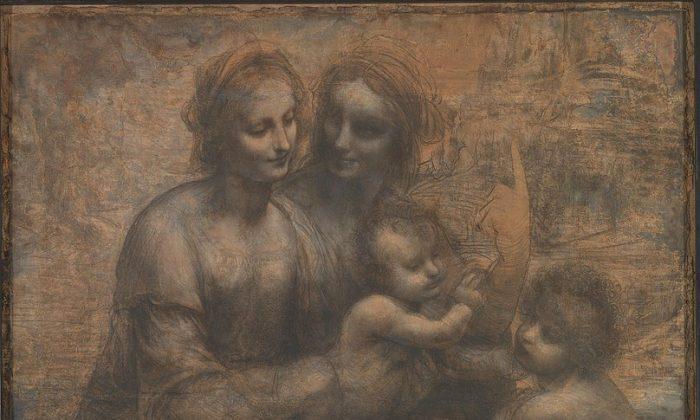If just one work by Leonardo da Vinci sings for me the word genius—genius, that is, in the original sense of the word, which describes a life guided by a spirit or even a higher power—it is his drawing “The Virgin and Child With Saint Anne and Saint John the Baptist.”
Scholars don’t agree when the work was created; some say as early as 1499 to 1500 and others as late as 1506 to 1508. Some just throw up their hands and say a range that encompasses the extremes of those dates.
The drawing is not a typical cartoon, which most often was a preparatory work for a painting or fresco. It bears no pricked holes along the sketched lines that would have been dusted with charcoal to transfer the image onto a canvas or wall. So it may be that Leonardo intended it as a completed work.
It is similar in subject matter to his painting “The Virgin and Child With Saint Anne,” now in the Louvre. But little St. John does not appear in that painting. Instead, the toddler Jesus is playing with a lamb, meant to symbolize the sacrificial lamb he is destined to become.


From Motherhood to Motherhood
Leonardo said a lot by setting these figures, as they are, in one nearly static pose. The drawing tells a story of motherhood through time—for nothing suggests the mother-child bond more aptly than a child on a mother’s lap.Over the generations, from lap to lap to lap, mothers hold their children until they see them off and into the world to embark on their own journeys. Of the two mothers, the larger and more substantial one is St. Anne, who holds her child Mary as an adult: Mary as a mother herself.
Mary cradles her own child, still a babe, as he reaches out. He is almost crawling away from her, out to his own future meeting with John the Baptist.
Reclaiming Meekness
Overall, it is Mary’s face that transfixes me. Was there ever a face with such sweetness, composure, innocence, and compassion? The longer I look, the deeper I feel these qualities have been immortalized.Mary, who exemplifies feminine virtues such as gentleness, modesty, deference, and nurturance, has long been a symbol of meekness, characterized, for example, in the Christmas carol “Silent Night” as “tender and mild.”
But while meekness can mean submissiveness, its synonyms include patience and forbearance, and even adjectives like long-suffering and resigned.
Anyone who’s been a mother or has closely watched a mother knows that patience is crucial to the role. But unless a child has turned wayward, we don’t often think of mothers as long-suffering.
But aren’t they? In the course of rearing a child and even in the years beyond those early ones, mothers are likely to endure the pain that their children do, whether it’s a cat scratch, doing poorly on a test, a romance turned sour, or bouts of chemotherapy. Every trial the child faces, the mother, in some measure, does as well.
What tremendous strength this requires! How strange that we should see these attributes as weakness. In the attributes of patience and forbearance, we can see in Mary the wisdom to gracefully submit to a power greater than her own. This, however, takes strength of character.
Leonardo makes just this point. Taking another look at Mary and Anne, we see that these women are not meek in the sense of weakness. Irrespective of the soft expressions on their faces, Leonardo embodied them with tremendous strength: These legs are more than sturdy. These laps are solid and can bear the weight of the world.

Radiant With Compassion
Somehow, with just touches of white chalk, Leonardo managed to show a soft light on St. Mary and the Christ child and around Mary’s head, and the light seems to emanate from within them. And both of these faces share the same three-quarter perspective.Anne and John, who both face and mirror Mary and Jesus, are slightly shaded, likely because the master artist wanted to acknowledge the lack of their spiritual status in comparison to that of the Madonna and child.
Baby Jesus seems to be wriggling out of Mary’s arms as she patiently watches him give a benediction to St. John, who one day will baptize him and set him on his journey as savior.
Strength and Compassion
The image of Anne’s finger pointing to heaven seems almost out of place in this intimate scene. As Anne gazes at her daughter, why is her hand telling us something else? It seems unconnected to the story of family love and God’s compassion.I believe Leonardo shows us a way to better ourselves spiritually. The finger is pointing to heaven for our sake.
How can what is depicted in this drawing speak to us? First, of course, we can understand that Anne and Mary represent more than mothers. It is not only mothers who can empathize with the pain of their children; fathers can as well. And, going one step further, the ability to show empathy and compassion is not reserved for parents alone.
Since every life in its course must submit to troubles, illnesses, and death, on this point, all humanity is one family. And we can, as all traditional spiritual paths remind us, treat each other with compassion as we suffer through life together.
But doing so requires patience to endure insults, disregard faults, and allow ourselves to feel each other’s troubles as our own.
How well Leonardo’s drawing reveals that enduring for others is the same thing as compassion. When we reach within for the strength to endure, we approach the sublime, and rest there in perfect composure and peace.





